Pruning is the only gardening chore you can do in mud season, because your plants (and the weeds!) are still frozen in the ground. It’s a great excuse to get outside and do something–actual gardening! The weather is very unsettled during mud season, so it’s best to be strategic about what gets pruned when. Your design goals will also factor into prioritizing jobs.
For example, the very first pruning I did this mud season focused on spring flowering shrubs whose branches I wanted to bring inside: February daphne, forsythia, and flowering quince (Chaenomeles). This was easy to do on a mild day, even with a couple of inches of snow still on the ground.
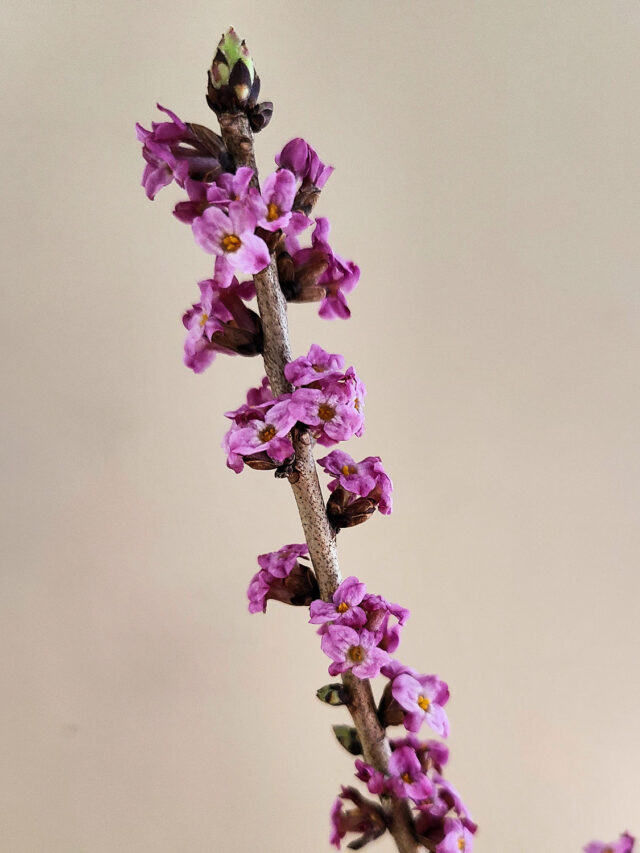
When I’m cutting branches for forcing, I try to only cut crossing branches or ones that need to come out for other reasons, rather than hacking away indiscriminately. The daphne branches were perfect for this purpose–full of buds. The forsythia, blooming ten days later than the daphne, only had a few flower buds this year, and I’m still waiting for the quince to flower. Some years the buds don’t open all the way, but when they do, it looks like this (pictured below).
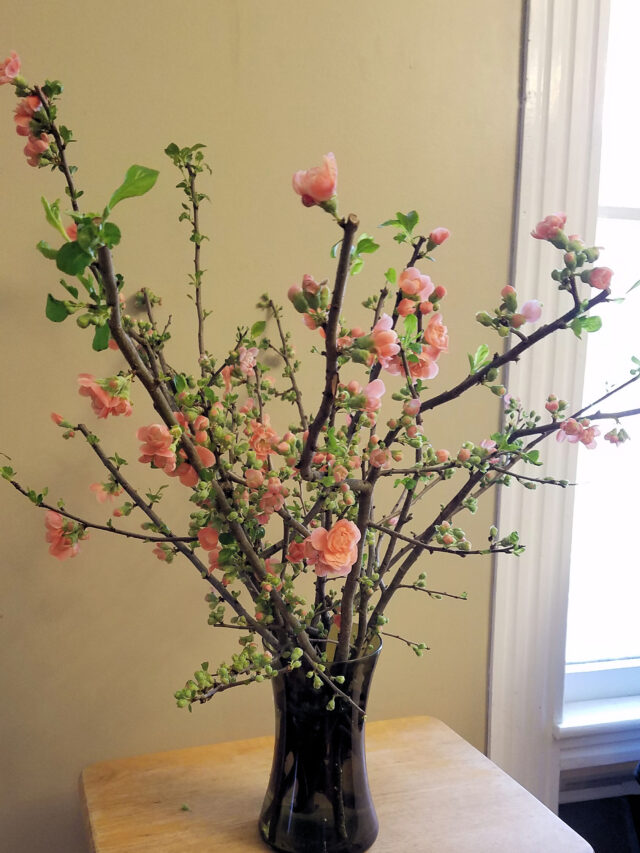
Of course, not every shrub needs pruning every year, especially if you did a good job matching the shrub’s mature height and width to the space available for it. But sometimes you want to prune a shrub because it looks better to you that way.
That’s why my next step was to shear my spireas into globes using hedge trimmers. The spireas are surrounded by perennials and bulbs, so I needed to do this job before the soil was the least bit defrosted.
In the past I’ve always preferred to let all of my shrubs retain their natural shape, but I’ve come to appreciate the contrast between clipped, geometrical shapes and organic forms in the garden. The spireas respond well to shearing, and since their new growth is the most intensely colored, they become a colorful counterweight to everything else going on in their respective beds.
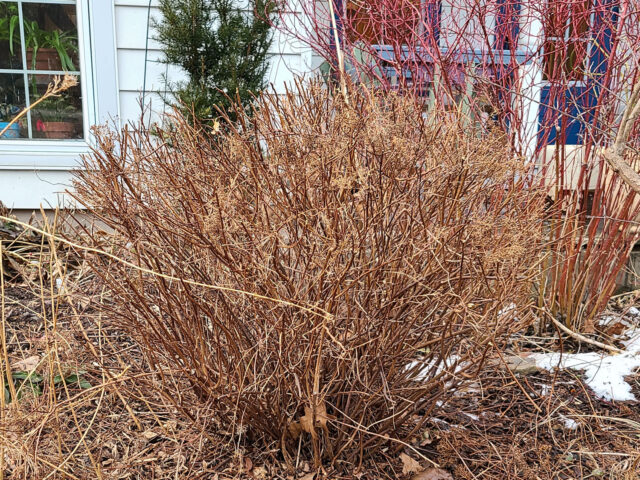
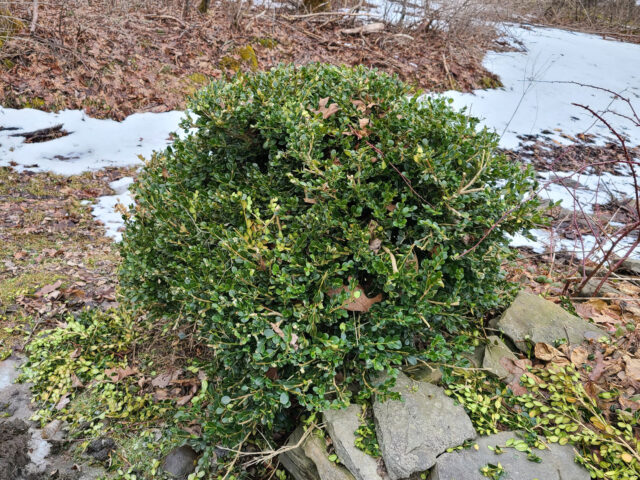
After I sheared the boxwood, I read that Proven Winners advises to avoid pruning boxwood until after the new growth emerges. Oh, well. I don’t think the early shearing will hurt this boxwood. It was planted by the previous owners and I don’t think I’ve touched it in the ten years we’ve lived here. It was misshapen with branches sticking out every which way, some half dead. Maybe next year I’ll trim it after the new growth emerges.
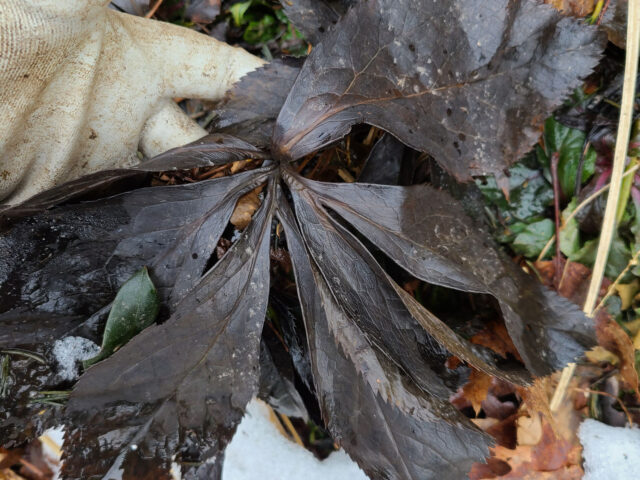
As soon as the hellebore leaves were no longer frozen to the ground, I started cutting them back. I’ve learned through observation and note-taking that the hellebore’s fresh new leaves and flowers look a lot better without the blackened slime surrounding them. In many climates, the hellebore foliage remains evergreen and attractive, but not here.
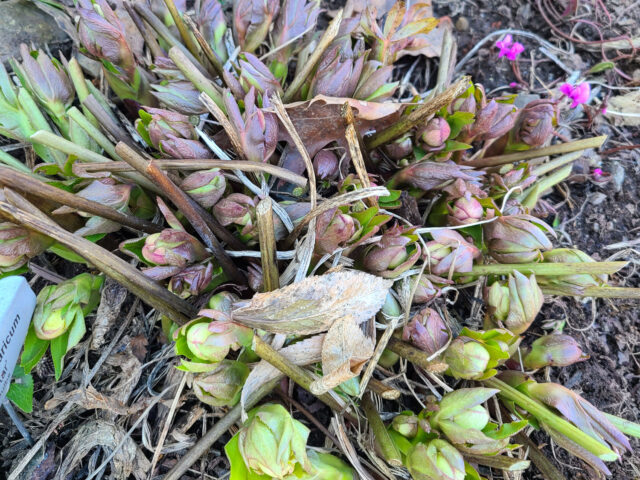
I also trimmed back the few epimediums I have for the same reason I trim back the hellebores: the flowers emerge quite early and look so much better without last year’s foliage.
I’m currently cutting down the peony foliage that I should have cut down last October. My peonies get plagued with botrytis and it reduces infection to remove the foliage in a timely manner. This isn’t timely but better late than never.
For the first time ever I took apart my Felcos and thoroughly cleaned and lubricated them. This video by Laura LeBoutillier of Garden Answer gave me courage.
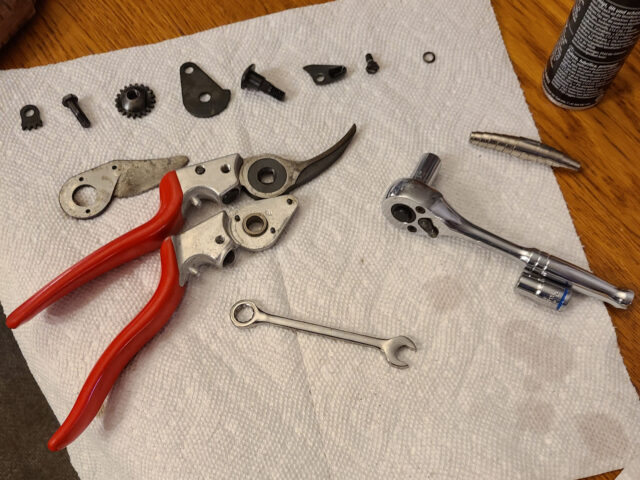
It helps to have a nice chunk of time set aside for this chore so you don’t feel rushed. Also, it will save a lot of aggravation if you find the right size tools to loosen the bolts before you start. In my household it’s not a given that the tools will be where they belong, and I have a different model pruner than Laura does so I needed a different size wrench, which I found by trial and error. But if you get everything you need together before you start, it’s doable.
Once my pruners were sharpened I trimmed my spring-blooming witch hazels back to the first bloom on each branch, while they were still blooming and I could see exactly where that spot was. I’ve been told this will encourage them to be more floriferous. We shall see.
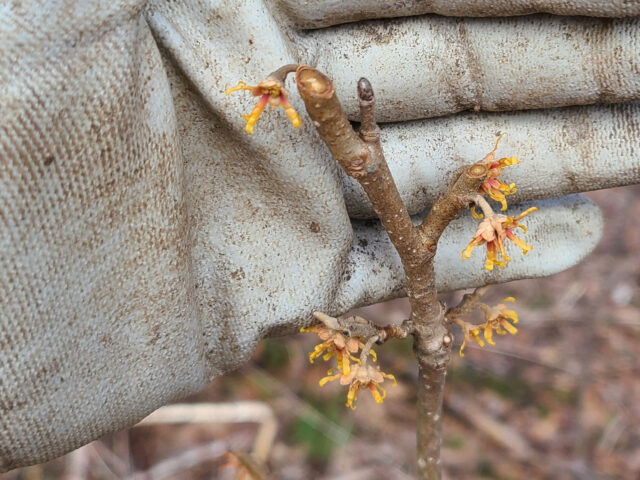
Pruning: What comes next?
So far all the pruning I’ve done was made easier by frozen or just-barely-thawed ground. I wanted the shrubs or plants to be dormant (or just waking up) when they were pruned. It needs to be a little warmer for the remaining pruning I want to do. That’s because I need the shrubs to show me where I need to cut.
I wait until I see swelling leaf buds before I prune Hydrangea paniculata (PeeGee types) and H. arborescens (Annabelle types) cultivars. But come to think of it, I really don’t have to wait, because you can prune them in spring or fall. I’ve never considered pruning them in autumn, because I like seeing snow on the dried flowers. But who am I kidding? If I never have time to get the peonies cut down before snow flies (and I really should do this job to prevent disease), I’m not going to have time to prune the hydrangeas.
Proven Winners advises pruning no more than 30% off either of these types. “For example, if your hydrangea is six feet tall, it is safe to prune as much as two feet off the top and sides.” Lee Reich, writing in The Pruning Book (aff link), says to cut them back to ground level, or a to permanent framework.
My friend Lee Ginenethal, mentioned below, has this method for pruning his H. paniculata ‘Limelight’: “First step- eliminate any branch that is not substantially thicker than a pencil. Shorten all new growth to the first or second set of buds. Final step- open the structure and shape for a rounded crown.” I think I will try Lee’s method this year. Berry White, Vanilla Strawberry, Limelight Prime, Bobo, Little Hottie, Little Quick Fire, Quick Fire Fab, Zinfin Doll, Quick Fire, Fire Light, and Fire Light Tidbit are the panicle hydrangeas in my garden.
Fun fact: Only H. paniculata can be trained into a tree form, which always confused me, because “arborescens” sounds more like it could be a tree, going by the botanical name. H. arborescens is the kind that suckers, which means it will gradually expand its territory. In my garden, this applies to the Incrediballs and the Invincibelles. (All my hydrangeas were sent to me to trial.)
Sounds like I should get cracking on pruning those hydrangeas! Why prune them at all? To keep them from becoming a complete thicket, full of congested branches that aren’t getting enough light. Once both species are well-established, they will grow to the height their genetics have determined. You can’t keep them shorter by pruning, so look at the tag before you buy and don’t grow one that’s the wrong mature size for the spot you have in mind.
Rose pruning
Roses–even hardy roses–often have dieback in my garden. I wait for the leaf buds on the roses to swell, so I can see exactly how much dead wood needs to be removed.
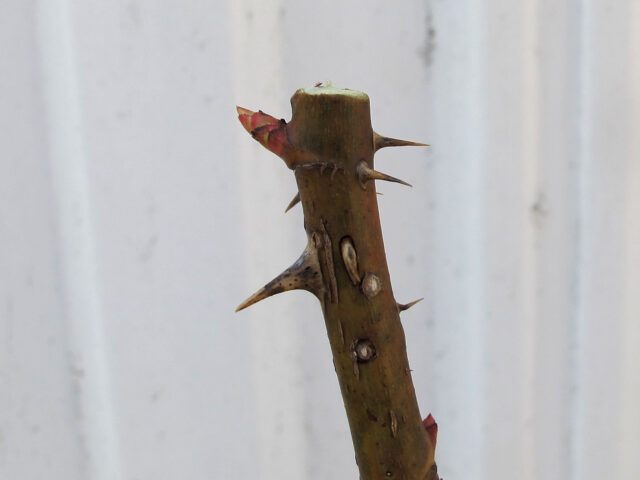
Lee Ginenthal of Der Rosenmeister Nursery has some videos on rose pruning if you want to dive deeper. These are all on Facebook. I’m not sure if you can see them if you don’t have an account.
- Pruning roses
- Pruning a climber
- How to prune and train a climber
- Pruning a rambling rose, Part 1
- Part 2 on pruning a rambler
- Part 3, pruning ramblers
- Part 4, pruning ramblers
- Part 5, last part on pruning ramblers
Whack jobs
This is the easiest kind of pruning: you just whack the whole thing to the ground. Last year I started doing this to the purple-leaved smokebush that was here when we moved in. I don’t know what variety it is, but it never makes “smoke”–the wispy-misty panicles of insignificant flowers that give smokebush its name. Some people don’t like the smoke, and they cut the shrub down every year because this causes the shrub to make bigger leaves.
Well, I like the smoke, but it’s clearly not showing up, probably because the flowers are killed by the cold. I started cutting it back to the ground last year. It made me nervous to take such drastic action, but it did eventually resprout, and the reddish purple leaves were bigger.
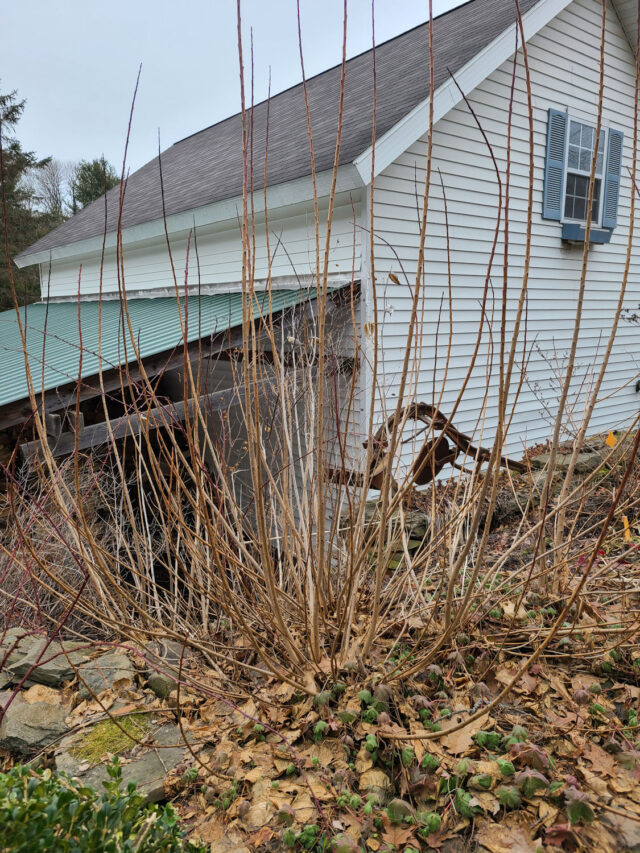
It can be cut back anytime before it leafs out, and since it leafs out on the late side, I tend to save it for later.
I usually only cut back the oldest branches of my redtwig dogwood, but this year I think I’m going to cut it all down to the ground to see what kind of difference it makes. The youngest branches are supposed to be the brightest red, and I can see that the oldest branches look more yellow at the base.
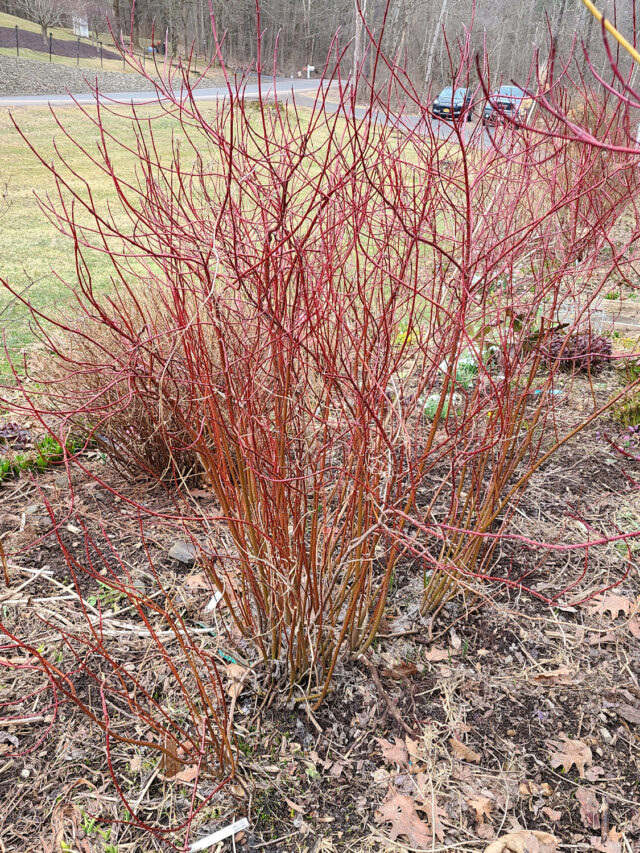
I’m also going to dig out those satellite shrubs and give them a new home. The vivid branches are one of the main features of this shrub, so I don’t want to cut it down until I have to–which is when I see buds starting to swell. I want to prune it before it expends any energy making leaves, because it won’t be keeping those leaves.
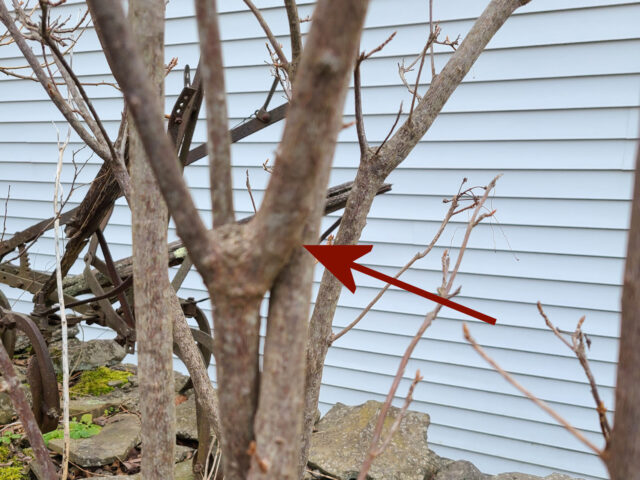
You’re supposed to prune crossing branches whenever you find them, but I’m going to wait until after this rhododendron blooms before I do that. Why? I’m going to have to cut a major branch, and I don’t want to lose all those potential flowers. It really won’t be mud season anymore by then!
As you can see, the reason you prune can make a difference for when you prune. I could prune those hydrangeas in autumn, but I like seeing snow on the dried flowers. The “right” time to prune spring-flowering shrubs is two weeks after they bloom–but I want to force the branches indoors, so I prune earlier. Instead of shearing the spireas into globe shapes, I could let them keep their natural form and just remove the oldest branches. And I could prune dead wood from the rose bushes in the middle of summer if I had to–but it’s a heck of a lot easier to do it before the shrub is leafed out. Some pruning decisions are made for aesthetics, and some are made for logistics. And I (or you) get to decide.





Thank you! This was very helpful 🙂
Linda, thanks for taking the time to let me know.
Hello,
Wouldn’t hydrangea be ok without pruning, I have a bush myself and I have never trimmed it. It still has a beautiful thick stem and seems to stay healthy even though the bush is so thick. Should I change this and if so, how should I trim my bush?
Best,
Ben
Hi, Ben–thanks for your question. There are several different species of hydrangea. Do you know what kind you have? Some kinds of hydrangea should never be pruned, and the others are pruned to make them look better. So I would say if you are happy with how your hydrangea looks, it doesn’t need pruning. Proven Winners describes the different kinds of hydrangeas and their pruning needs here, if you want to learn more.
Regarding smoke bush.
Here in Virginia there is an insect that enters newly cut stems on smoke bush and kills it. So it is advisable to only prune in winter or use a sealer.
Thank you, Tracy–good to know. I hadn’t heard of that insect.
Thank you for this pruning tour! As you say, many elements come into play, time available and weather conditions being two of them. I have lots of roses and their pruning is a big job. As I work I keep repeating this English mantra to myself: ‘dead, diseased, weak and crossing’. And I’ve had to add ‘check for holes in the stems’ as fly/moth (not sure of the type) is now attacking roses by laying eggs in stems cut the previous year: the larvae then eat their way through the tender centre of the stem, sometimes right back to the roots, and the rose bush is weakened or killed. Lovely. Have you ever encountered this nasty insect?
I haven’t come across it but I don’t have a lot of roses and the ones I do have don’t all grow near each other.
excellent article! Now I am motivated 🙂
I’m glad you found it helpful.
With the rose pruning you should really prune at a slight angle and not straight across, and make sure the lower part of the angled cut is above the point of the flower/leaf bud.
Monica, that is certainly the traditional advice, and that is what Lee Reich recommends in his book. But I have read conflicting advice. For example, in this video, Ludwig states “A straight, 90 degree cut is preferred to a slanted cut. The exposed wound is smaller and seals quicker.” I have read this in other places but of course I can’t think of where. I think more important than the angle of the cut is its location relative to a bud: not too close, lest it dry out, and not too far away, because you will leave a stump.